trailer VOLKSWAGEN CARAVELLE 1992 T4 / 4.G Owners Manual
[x] Cancel search | Manufacturer: VOLKSWAGEN, Model Year: 1992, Model line: CARAVELLE, Model: VOLKSWAGEN CARAVELLE 1992 T4 / 4.GPages: 164, PDF Size: 25 MB
Page 5 of 164
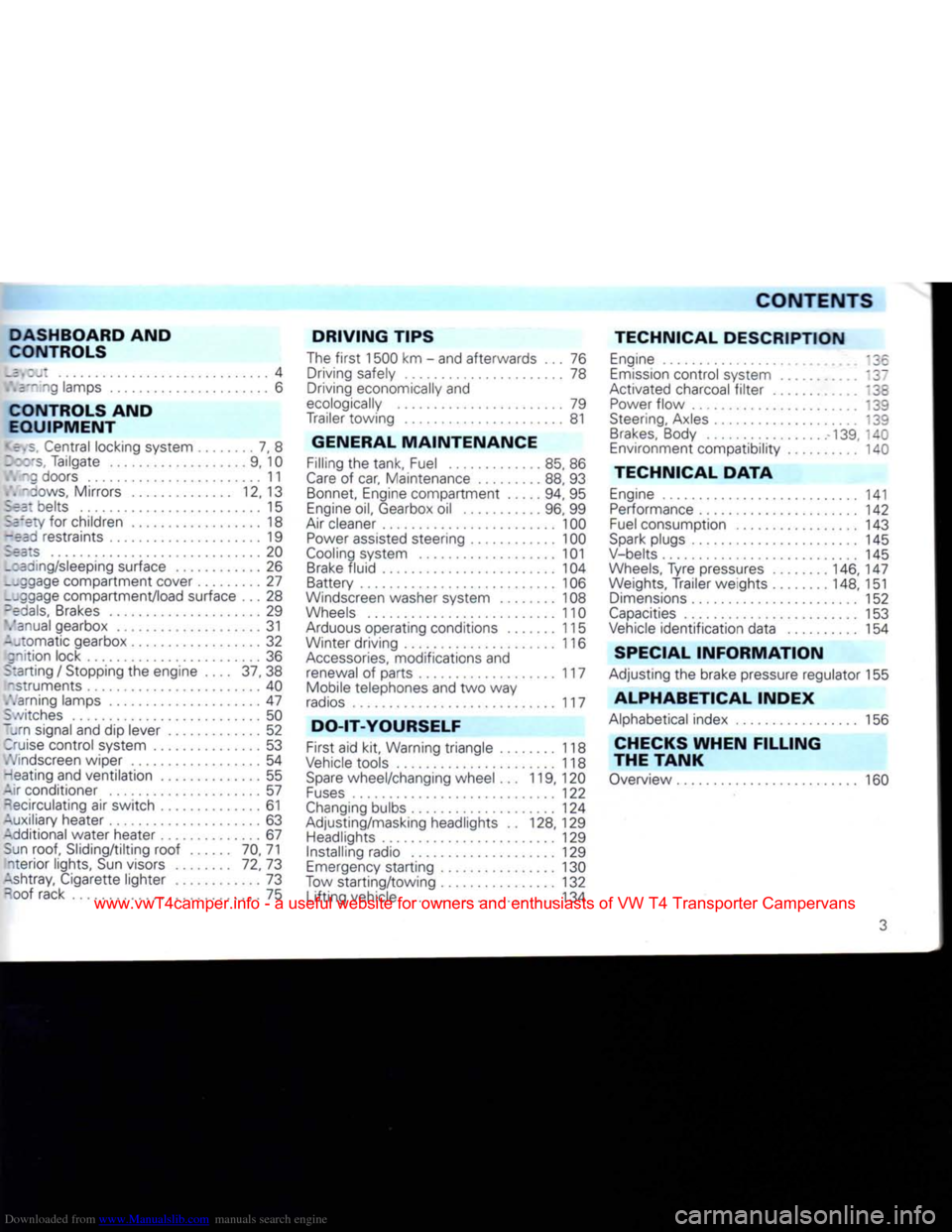
Downloaded from www.Manualslib.com manuals search engine
CONTENTS
DASHBOARD AND
CONTROLS
Layout
4
i\='-:ng
lamps 6
CONTROLS
AND
EQUIPMENT
•
e.s. Central locking system 7, 8
I:cs, Tailgate 9, 10
I'I
~g doors 11
..
-^ows, Mirrors 12, 13
Sea: belts 15 5re:y for children 18
-ead restraints 19
Seats
20 _:ariing/sleeping surface 26
__ggage
compartment cover 27 __cgage compartment/load surface ... 28
-edals, Brakes 29 Vanual gearbox 31
--tomatic gearbox 32
gnition
lock 36
Starting / Stopping the engine .... 37, 38 "struments 40
.'.
arning lamps 47
Switches 50
~yn signal and dip lever 52
3'uise
control system 53 .'.'indscreen wiper 54
-eating and ventilation 55
Air
conditioner 57
Recirculating air switch 61
Auxiliary heater 63
Additional
water heater 67
Sun roof, Sliding/tilting roof 70, 71
nterior lights, Sun visors 72, 73
Ashtray, Cigarette lighter 73
-oof
rack 75
DRIVING
TIPS
The first 1500 km - and afterwards ... 76 Driving safely 78
Driving economically and
ecologically
79
Trailer towing 81
GENERAL
MAINTENANCE
Filling the tank, Fuel 85, 86
Care of car, Maintenance 88, 93 Bonnet, Engine compartment 94, 95
Engine oil, Gearbox oil 96, 99
Air
cleaner 100 Power assisted steering 100
Cooling
system 101
Brake fluid 104
Battery 106
Windscreen washer system 108
Wheels 110
Arduous operating conditions 115
Winter driving 116
Accessories, modifications and
renewal of parts 117
Mobile
telephones and two way
radios 117
DO-IT-YOURSELF
First
aid kit, Warning triangle 118
Vehicle tools 118 Spare wheel/changing wheel ... 119, 120
Fuses
122
Changing
bulbs 124
Adjusting/masking headlights .. 128,129
Headlights 129
Installing radio 129
Emergency starting 130
Tow starting/towing 132
Lifting vehicle 134
TECHNICAL
DESCRIPTION
Engine 136
Emission control system 137
Activated charcoal filter '38 Power flow '39
Steering, Axles 139 Brakes, Body -139,
1
AC
Environment compatibility 140
TECHNICAL
DATA
Engine 141
Performance 142
Fuel consumption 143
Spark plugs 145
V-belts 145
Wheels,
Tyre
pressures 146, 147
Weights,
Trailer weights 148, 151 Dimensions 152
Capacities 153
Vehicle identification data 154
SPECIAL
INFORMATION
Adjusting the brake pressure regulator 155
ALPHABETICAL
INDEX
Alphabetical index 156
CHECKS
WHEN
FILLING
THE TANK
Overview 160
3
www.vwT4camper.info - a useful website for owners and enthusiasts of VW T4 Transporter Campervans
Page 8 of 164
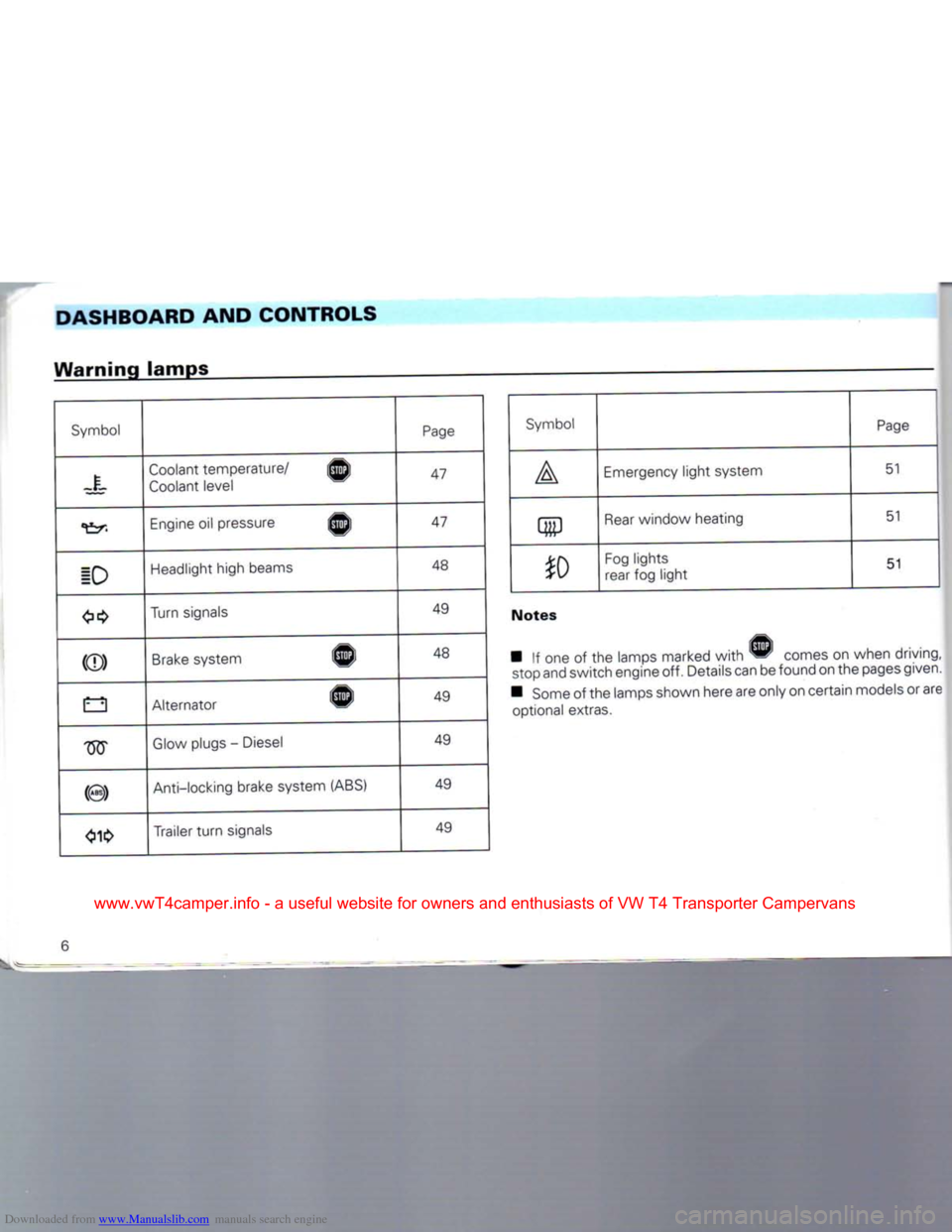
Downloaded from www.Manualslib.com manuals search engine
DASHBOARD
AND
CONTROLS
Warning lamps
Symbol Page Symbol
Page
Coolant temperature/
Coolant level
47
A Emergency light system
51
Engine oil pressure f^i
47
m Rear
window
heating
51
ID
Headlight
high
beams
48
to Fog lights
rear fog light 51
Turn
signals
49
Notes
((D)
Brake
system l^i
48
•
If one of the lamps marked
with
comes on when driving
stop and switch engine off. Details can be found on the pages
given
B Some of the lamps shown here are
only
on certain models or are optional extras.
£3
Alternator
49 •
If one of the lamps marked
with
comes on when driving
stop and switch engine off. Details can be found on the pages
given
B Some of the lamps shown here are
only
on certain models or are optional extras.
m Glow plugs - Diesel
49
(©)
Anti-locking brake system (ABS)
49
Trailer turn signals
49
6
www.vwT4camper.info - a useful website for owners and enthusiasts of VW T4 Transporter Campervans
Page 47 of 164
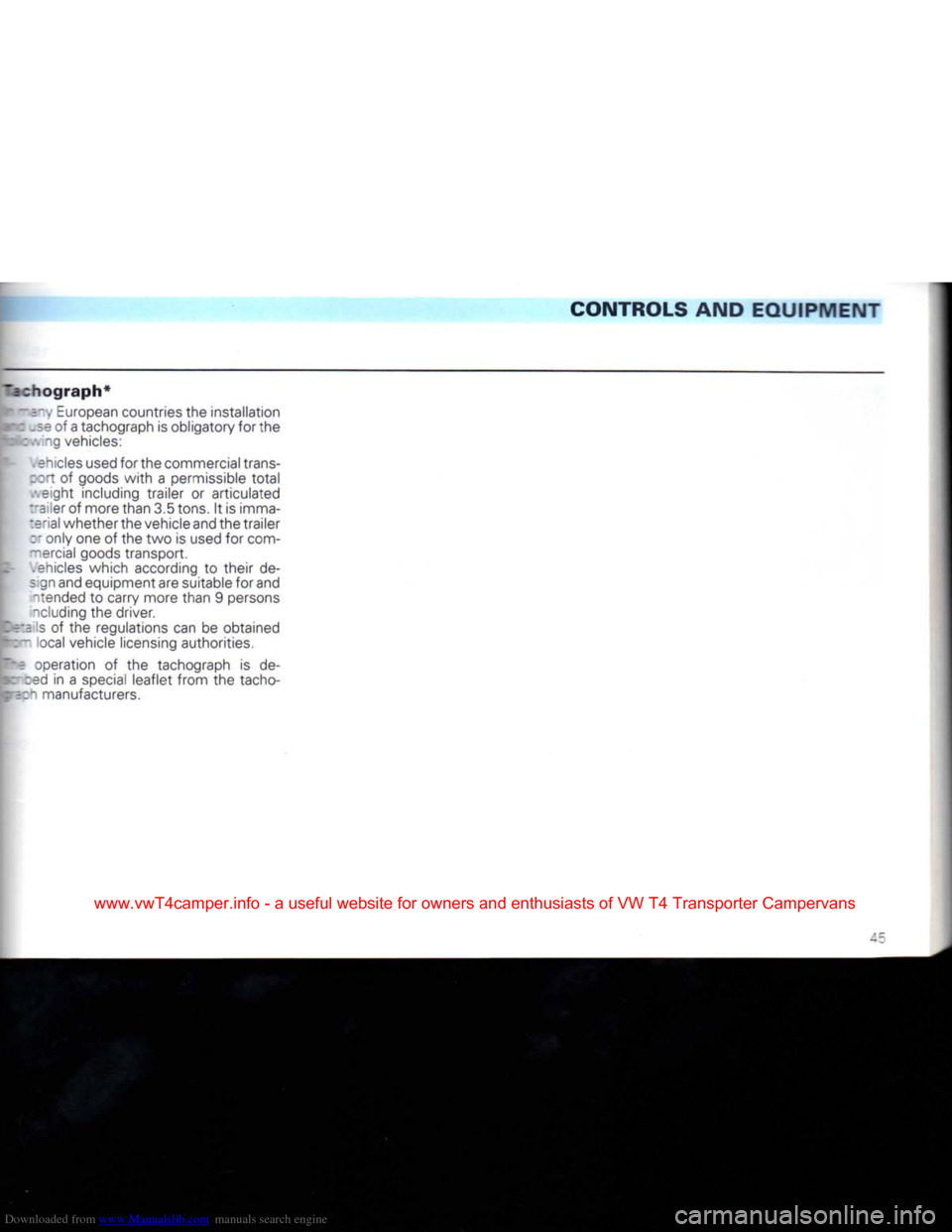
Downloaded from www.Manualslib.com manuals search engine
CONTROLS
AND
EQUIPMENT
~5chograph* i ----. European countries the installation of a tachograph is obligatory for the
:
ng vehicles:
.
ehicles used for the commercial trans-
zort
of goods
with
a permissible total .-.eight including trailer or articulated
"3
ler of more than 3.5 tons. It is imma
terial whether the vehicle and the trailer
"
only
one of the two is used for com
mercial goods transport.
1
.ehicles which according to their de-
s
gn and equipment are suitable for and "tended to carry more than 9 persons
ncluding
the driver.
Z M= s of the regulations can be obtained
i: - ocal vehicle licensing authorities.
operation of the tachograph is de-
::-
;sd in a special leaflet from the tacho-
ra;~
manufacturers.
www.vwT4camper.info - a useful website for owners and enthusiasts of VW T4 Transporter Campervans
Page 50 of 164
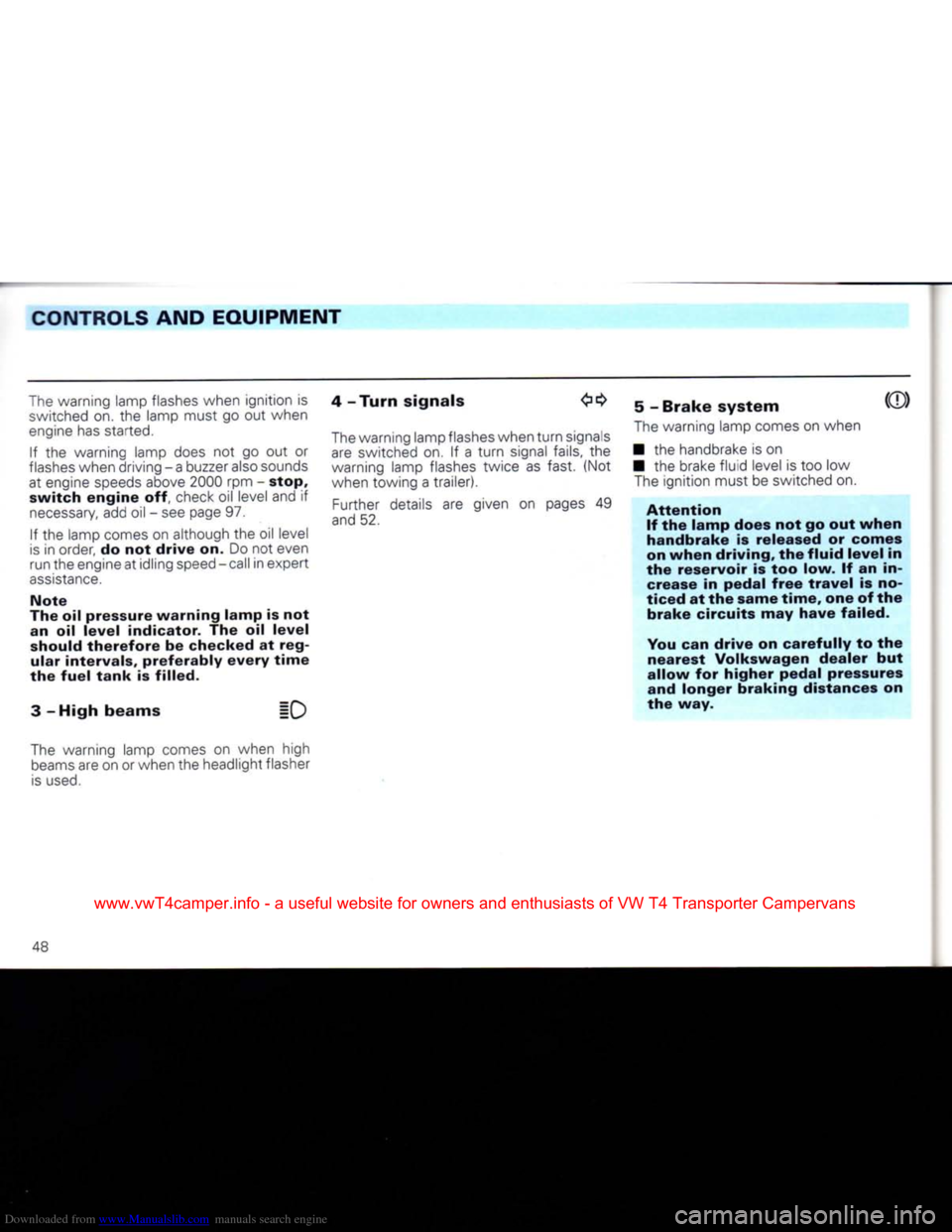
Downloaded from www.Manualslib.com manuals search engine
CONTROLS
AND EQUIPMENT
The
warning lamp flashes when ignition is
switched
on. the lamp must go out when
engine
has started.
If the warning lamp does not go out or
flashes
when driving - a buzzer also sounds
at engine speeds above 2000 rpm - stop,
switch
engine
off, check oil level and if
necessary,
add oil - see page 97.
If the lamp comes on although the oil level
is
in order, do not
drive
on. Do not even
run the engine at idling speed-call in expert
assistance.
Note
The oil pressure
warning
lamp
is not an oil
level
indicator.
The oil
level
should
therefore
be checked at reg
ular
intervals,
preferably
every
time
the
fuel
tank
is filled.
3 -
High
beams 10 4 - Turn signals
The
warning lampflashes when
turn
signals
are
switched on. If a
turn
signal fails, the
warning lamp flashes twice as fast. (Not
when towing a trailer).
Further
details are given on pages 49
and
52. 5 -
Brake
system «^
The
warning lamp comes on when
• the handbrake is on
• the brake fluid level is too low
The
ignition must be switched on.
Attention
If the
lamp
does not go out
when
handbrake
is released or comes
on
when
driving, the
fluid
level
in
the reservoir is too low. If an in crease in
pedal
free
travel
is no
ticed
at the same
time,
one of the
brake
circuits may
have
failed.
You can
drive
on
carefully
to the
nearest
Volkswagen
dealer
but
allow
for
higher
pedal
pressures and longer
braking
distances on
the way.
The
warning lamp comes on when high
beams
are on or when the headlight flasher
is
used.
48
www.vwT4camper.info - a useful website for owners and enthusiasts of VW T4 Transporter Campervans
Page 51 of 164
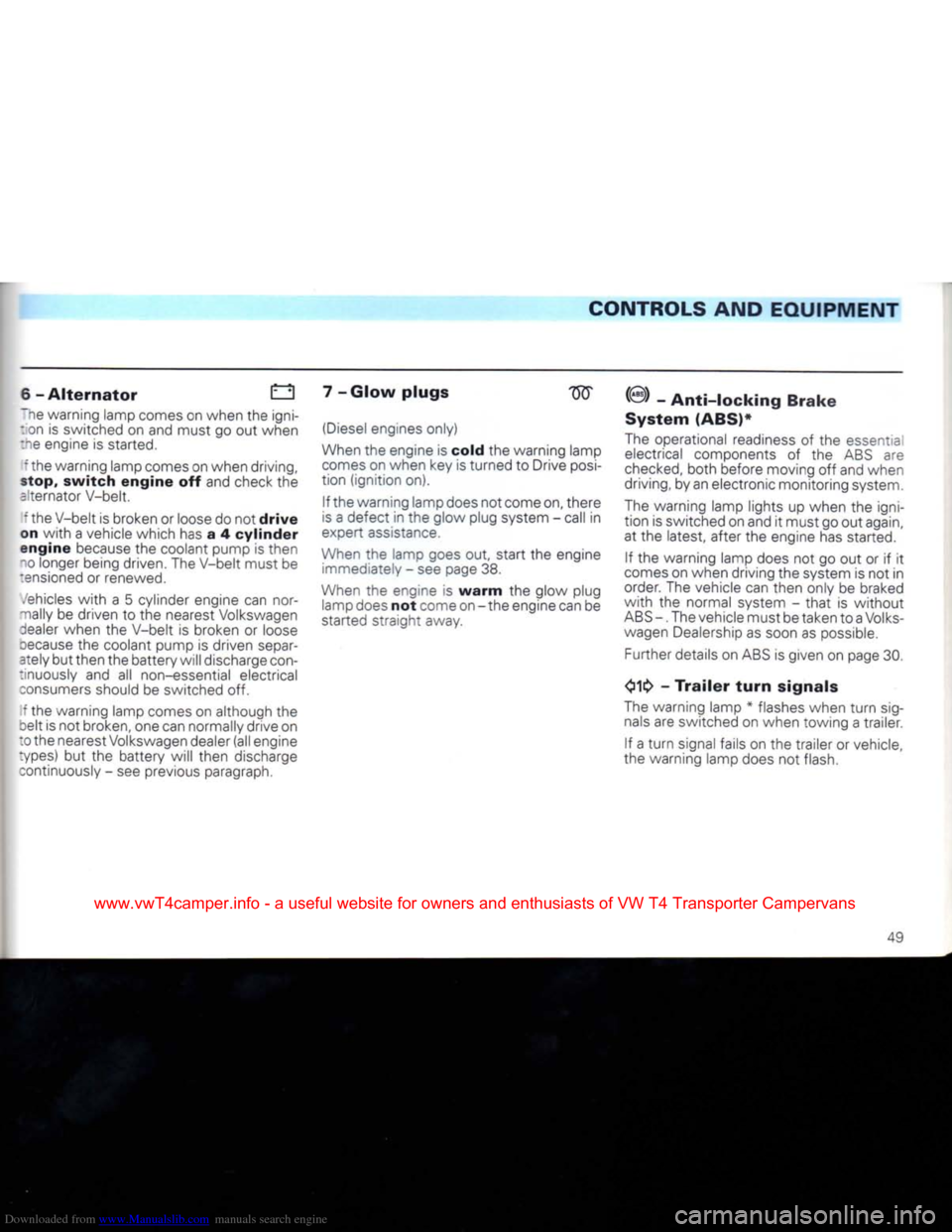
Downloaded from www.Manualslib.com manuals search engine
CONTROLS
AND
EQUIPMENT
6-Alternator
Q
~ne warning lamp comes on when the
igni-
I
on
is
switched on and must go out when
She
engine
is
started.
i the warning lamp comes on when driving,
stop,
switch
engine
off
and
check
the
alternator V-belt.
f the V-belt
is
broken or loose do not
drive
on with
a
vehicle which
has a 4 cylinder
engine
because the coolant pump
is
then
no
longer being driven. The V-belt must
be
tensioned
or
renewed.
ehicles with
a 5
cylinder engine
can
nor
mally
be
driven to the nearest Volkswagen
dealer when
the
V-belt
is
broken
or
loose oecause
the
coolant pump
is
driven separ
ately but then the battery will discharge
con
tinuously
and all
non-essential electrical consumers should
be
switched
off.
f the warning lamp comes on although
the
belt
is
not broken, one can normally drive on
to
the nearest Volkswagen dealer (all engine
types)
but the
battery will then discharge
continuously
- see
previous paragraph.
7-Glow
plugs
W
(Diesel engines only)
When
the engine
is cold
the warning lamp comes on when key
is
turned to Drive
posi
tion
(ignition on).
If
the warning lamp does not come
on,
there
is
a
defect in the glow plug system
-
call
in
expert assistance.
When
the
lamp goes out,
start
the engine
immediately
-
see page
38.
When
the
engine
is warm the
glow plug
lamp
does
not
come on -the engine can
be
started straight
away.
(®)
-
Anti-locking
Brake
System
(ABS)*
The operational readiness
of the
essential electrical components
of the ABS are
checked,
both before moving off and when
driving,
by an electronic monitoring system.
The warning lamp lights up when
the
igni
tion
is
switched on and
it
must go out again, at the latest, after the engine
has
started.
If
the warning lamp does not go out
or if it
comes on when driving the system
is
not
in
order.
The
vehicle can then only
be
braked
with
the
normal system
-
that
is
without
ABS-.The vehicle must be taken to a Volks
wagen Dealership
as
soon
as
possible.
Further details on ABS
is
given on page
30.
<]1i>
-
Trailer
turn
signals
The warning lamp
*
flashes when turn
sig
nals are switched on when towing
a
trailer.
If a
turn signal fails on the trailer or vehicle,
the warning lamp does not flash.
www.vwT4camper.info - a useful website for owners and enthusiasts of VW T4 Transporter Campervans
Page 53 of 164
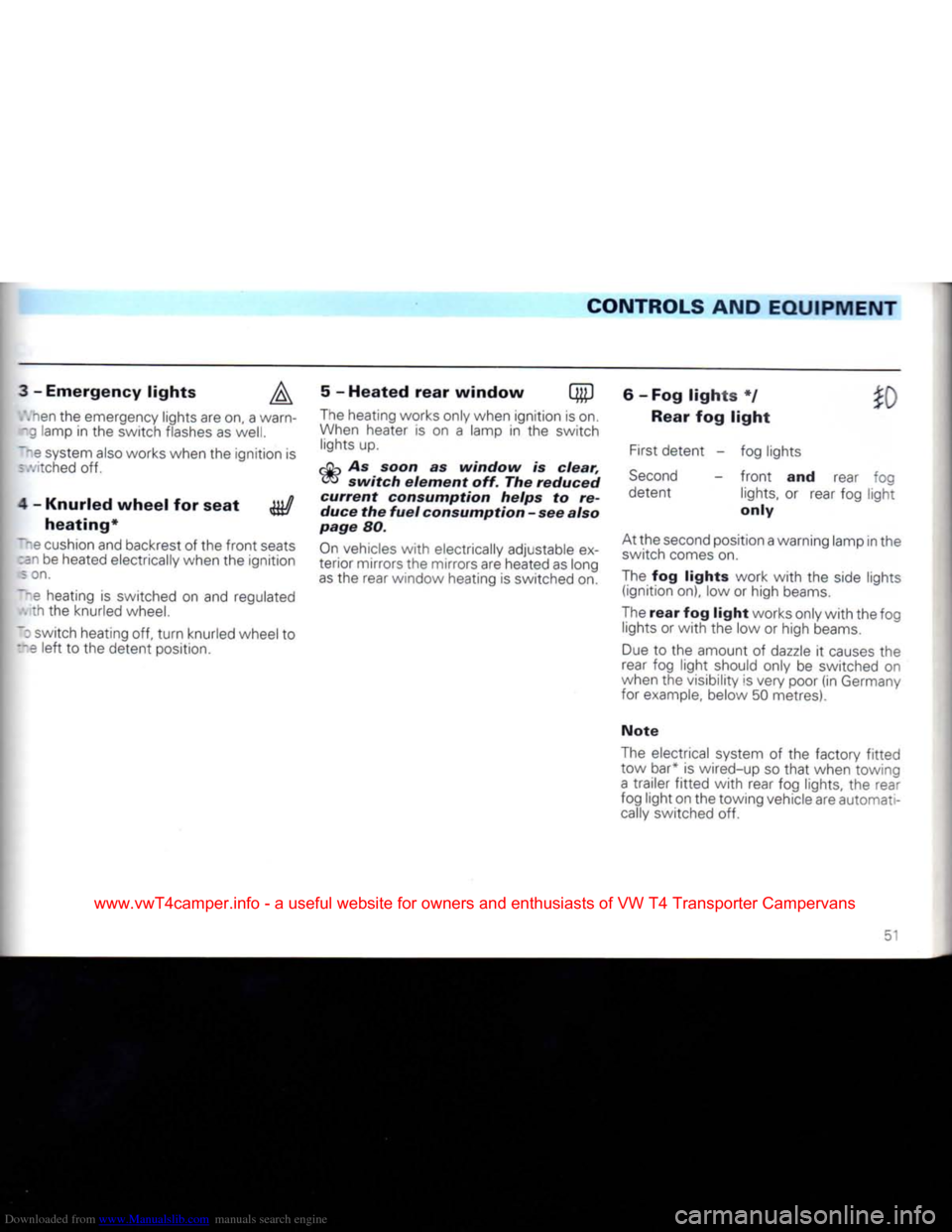
Downloaded from www.Manualslib.com manuals search engine
CONTROLS
AND
EQUIPMENT
3
-
Emergency lights .
nen the emergency lights are on, a warn-
'z lamp in the switch flashes as well.
Ine system also works when the ignition is
;
.-.itched off.
4
-
Knurled wheel for seat
^Jf
heating*
~~e cushion and backrest of the
front
seats
:
=
n
be heated electrically when the ignition
s
on.
_~e
heating is switched on and regulated .vth the knurled wheel.
•
switch heating off,
turn
knurled wheel to
:_e
left
to the detent position.
5
-
Heated rear window
QpJ
The
heating works only when ignition is on.
When
heater is on a lamp in the switch lights up.
As soon
as
window
is
clear,
switch element
off. The
reduced
current consumption helps
to re
duce
the
fuel
consumption
- see
also
page
80.
On
vehicles
with
electrically adjustable ex
terior mirrors the mirrors are heated as long
as
the rear window heating is switched on.
6
-
Fog lights •/
|Q
Rear fog light
First
detent - fog lights
Second
-
front
and rear fog
detent lights, or rear fog
light
only
At the second position a warning lamp in the switch comes on.
The fog lights
work
with
the side lights (ignition on), low or high beams.
The rear fog light
works only
with
the fog lights or
with
the low or high beams.
Due
to the amount of
dazzle
it
causes
the
rear
fog
light
should only be switched on
when the visibility is very poor (in Germany
for example, below 50 metres).
Note
The
electrical system of the factory
fitted
tow bar* is wired-up so
that
when towing
a
trailer
fitted
with
rear fog lights, the rear
fog
light
on the towing vehicle are automati
cally
switched off.
51
www.vwT4camper.info - a useful website for owners and enthusiasts of VW T4 Transporter Campervans
Page 78 of 164
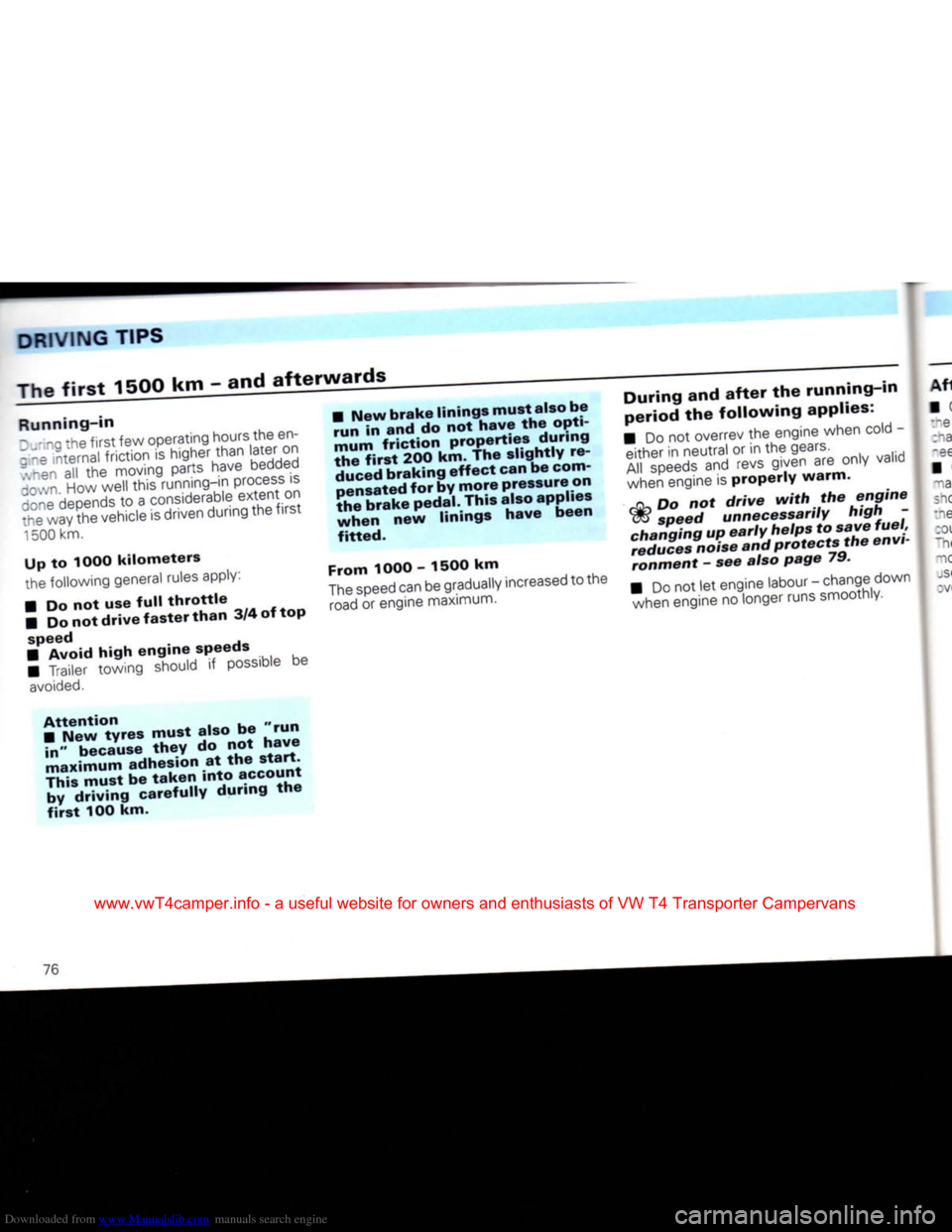
Downloaded from www.Manualslib.com manuals search engine
DRIVING
TIPS
The
first
1500 km - and
afterwards
Running-in
I/-c :he
first
few operating hours the en-
5ine
internal friction is higher than later on .-.hen all the moving parts have bedded
down.
How well this running-in process is
::cne
depends to a considerable extent on
the way the vehicle is driven during the
first
1500
km.
Up to 1000
kilometers
the following general rules apply:
• Do not use
full
throttle
• Do not
drive
faster
than
3/4 of top speed
• Avoid
high
engine
speeds
• Trailer towing should if possible be
avoided.
Attention
• New
tyres
must
also be "run in" because
they
do not
have
maximum
adhesion at the
start.
This
must
be
taken
into
account by
driving
carefully
during
the
first
100 km. • New
brake
linings
must
also be
run in and do not
have
the opti
mum
friction
properties
during
the
first
200 km. The
slightly
re duced
braking
effect
can be com
pensated
for by
more
pressure on
the
brake
pedal. This also applies
when
new linings
have
been
fitted.
From 1000 - 1500 km
The
speed can be gradually increased to the road or engine maximum.
During
and
after
the
running-in
period
the
following
applies:
• Do not overrev the engine when cold - either in neutral or in the gears.
All
speeds and revs given are only valid
when engine is
properly
warm.
Do not
drive
with
the
engine
speed
unnecessarily
high
changing
up
early
helps
to
save
fuel,
reduces
noise
and
protects
the
envi
ronment
- see
also
page
79.
• Do not let engine labour - change down when engine no longer runs smoothly.
76
www.vwT4camper.info - a useful website for owners and enthusiasts of VW T4 Transporter Campervans
Page 81 of 164
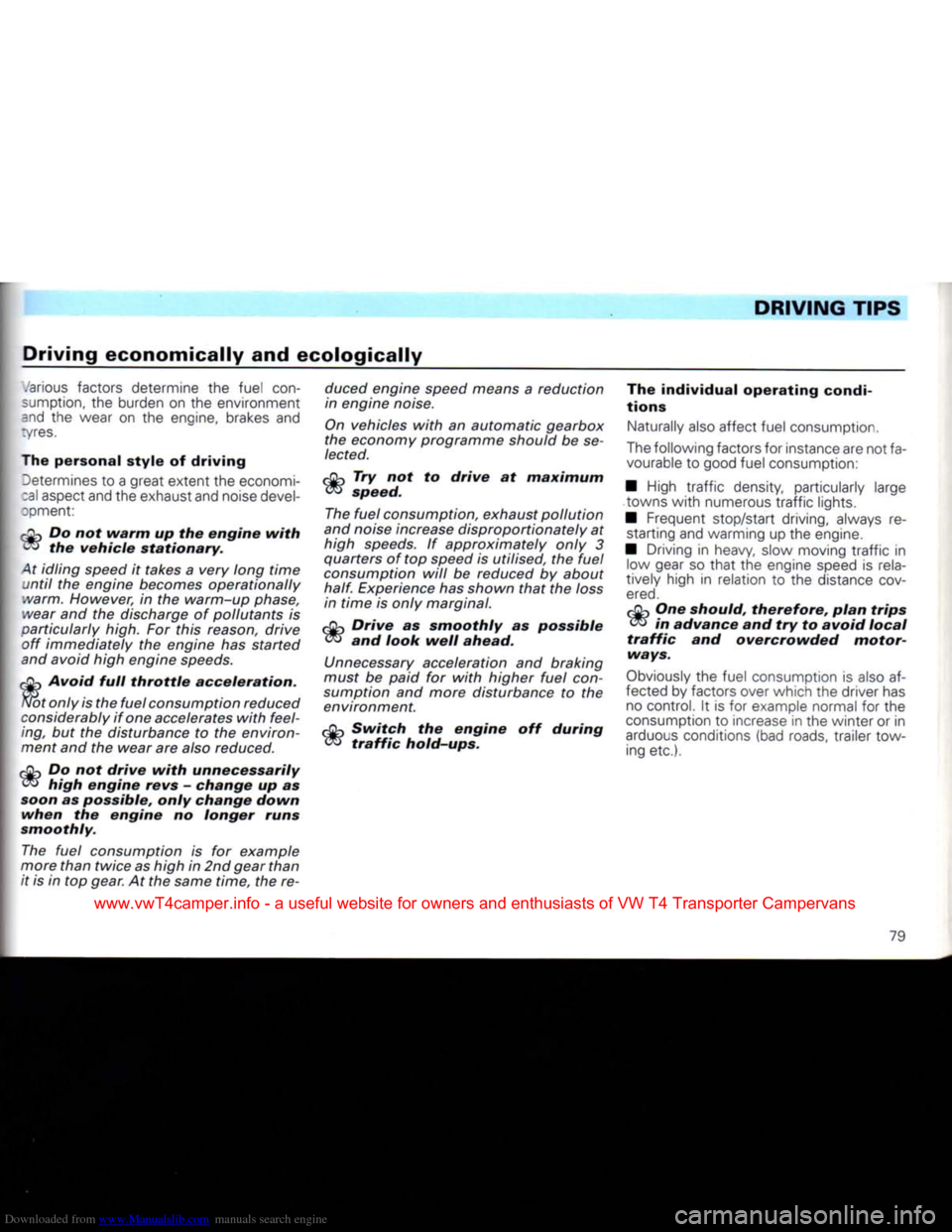
Downloaded from www.Manualslib.com manuals search engine
DRIVING
TIPS
Driving economically and ecologically
.'arious
factors determine the fuel
con
sumption,
the burden on the environment
and
the wear on the engine, brakes and
lyres.
The personal style of driving
Determines
to a great extent the economi-
:al
aspect and the exhaust and noise
devel
opment:
jOp
Do not
warm
up the
engine
with
W» the
vehicle
stationary.
At idling speed it takes a very long
time
until
the engine becomes operationally
warm. However, in the warm-up phase,
wear and the discharge of pollutants is
oarticularly high. For
this
reason, drive
off immediately the engine has started
and avoid
high
engine speeds.
f
h Avoid
full
throttle
acceleration.
of only is the
fuel
consumption reduced
considerably
if one accelerates
with
feel
ing, but the disturbance to the environ
ment
and the wear are also reduced.
rflri
Do not
drive
with
unnecessarily
high
engine
revs
-
change
up as
soon as possible,
only
change
down
when
the
engine
no
longer
runs
smoothly.
The
fuel
consumption is for example
more
than
twice as
high
in 2nd gear
than
it is in top
gear.
At the same
time,
the re duced engine speed means a reduction
in engine noise.
On vehicles
with
an automatic gearbox
the economy programme should be se
lected.
c^p
Try not to
drive
at
maximum
TO
speed.
The
fuel
consumption, exhaust pollution
and noise increase disproportionately at
high
speeds. If approximately only 3
quarters of top speed is utilised, the
fuel
consumption
will
be reduced by about
half.
Experience has shown
that
the loss in
time
is only marginal.
c
j-,
Drive
as
smoothly
as possible and
look
well
ahead.
Unnecessary
acceleration and braking
must
be paid for
with
higher
fuel
con
sumption and more disturbance to the environment.
Switch
the
engine
off
during
hold-ups. The individual
operating
condi
tions
Naturally
also
affect fuel consumption.
The
following factors for instance are not fa
vourable
to good fuel consumption:
•
High traffic density, particularly large
.towns with numerous traffic lights.
•
Frequent stop/start driving, always restarting and warming up the engine.
•
Driving in heavy, slow moving traffic in
low
gear so that the engine speed is
rela
tively high in relation to the distance cov
ered.
CQ~, One
should,
therefore,
plan
trips
in
advance
and try to
avoid
local
traffic
and
overcrowded
motor
ways.
Obviously
the fuel consumption is
also
af
fected
by factors over which the driver has
no
control. It is for example normal for the
consumption
to increase in the winter or in
arduous
conditions (bad roads, trailer tow ing etc.).
79
www.vwT4camper.info - a useful website for owners and enthusiasts of VW T4 Transporter Campervans
Page 83 of 164
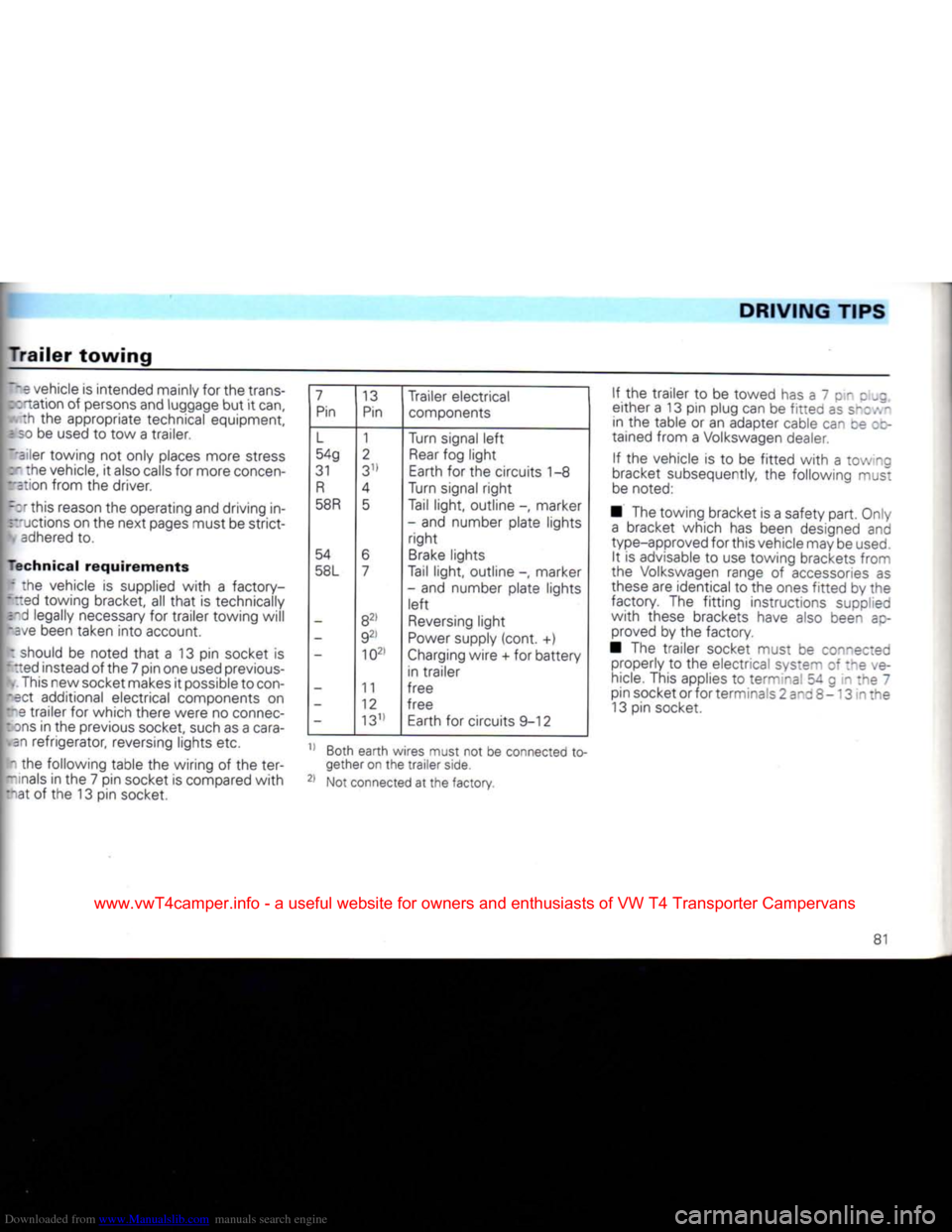
Downloaded from www.Manualslib.com manuals search engine
DRIVING
TIPS
Trailer
towing
~~e
vehicle is intended mainly for the trans-
cctation of persons and luggage but it can, th the appropriate technical equipment,
=
so be used to tow a trailer.
Ibiler towing not only places more stress : - the vehicle, it also calls for more concen-
ration from the driver.
::r this reason the operating and driving inductions on the next pages must be strict- . adhered to.
Technical
requirements
" :he vehicle is supplied
with
a factory-
• ::ed towing bracket, all
that
is technically -
d
legally necessary for trailer towing will =ve been taken into account.
: should be noted
that
a 13 pin socket is
::ed
instead of the 7 pin one used previous- . This new socket makes it possible to con-
ect additional electrical components on trailer for which there were no connec-
ns
in the previous socket, such as a
cara-
n refrigerator, reversing lights etc.
the following table the wiring of the ter-
nals
in the 7 pin socket is compared
with
at of the 13 pin socket.
I a 7
13
Trailer electrical
Pin Pin
components
L
1 Turn signal
left
54g
2
Rear
fog light
31
311
Earth
for the circuits 1-8
R
4
Turn signal
right
58
R
5
Tail
light, outline -, marker
- and number plate lights
right
54 6
Brake
lights
58L
7
Tail
light, outline -, marker
- and number plate lights
left
- 82>
Reversing
light
-
92!
Power
supply (cont. +)
-
102!
Charging
wire + for battery
in trailer
- 11
free
- 12
free
-
1311
Earth
for circuits 9-12
1) Both earth wires must not be connected to gether on the trailer side.
21 Not connected at the factory. If the trailer to be towed has a 7 pin plug,
either a 13 pin plug can be
fitted
as shown
in the table or an adapter cable can ce zz-
tained from a Volkswagen dealer.
If the vehicle is to be
fitted
with
a towing
bracket subsequently, the following must
be
noted:
• The towing bracket is a safety part. Only
a
bracket which has been designed and
type-approved for this vehicle may be
used.
It is advisable to use towing brackets from
the Volkswagen range of accessories as
these
are identical to the ones
fitted
by the
factory. The
fitting
instructions supplied
with
these brackets have also been ap proved by the factory.
• The trailer socket must be connected properly to the electrical system of the ve
hicle.
This applies to terminal 54 g in the 7
pin socket or for terminals 2 and 8 -13 in the
13
pin socket.
81
www.vwT4camper.info - a useful website for owners and enthusiasts of VW T4 Transporter Campervans
Page 84 of 164
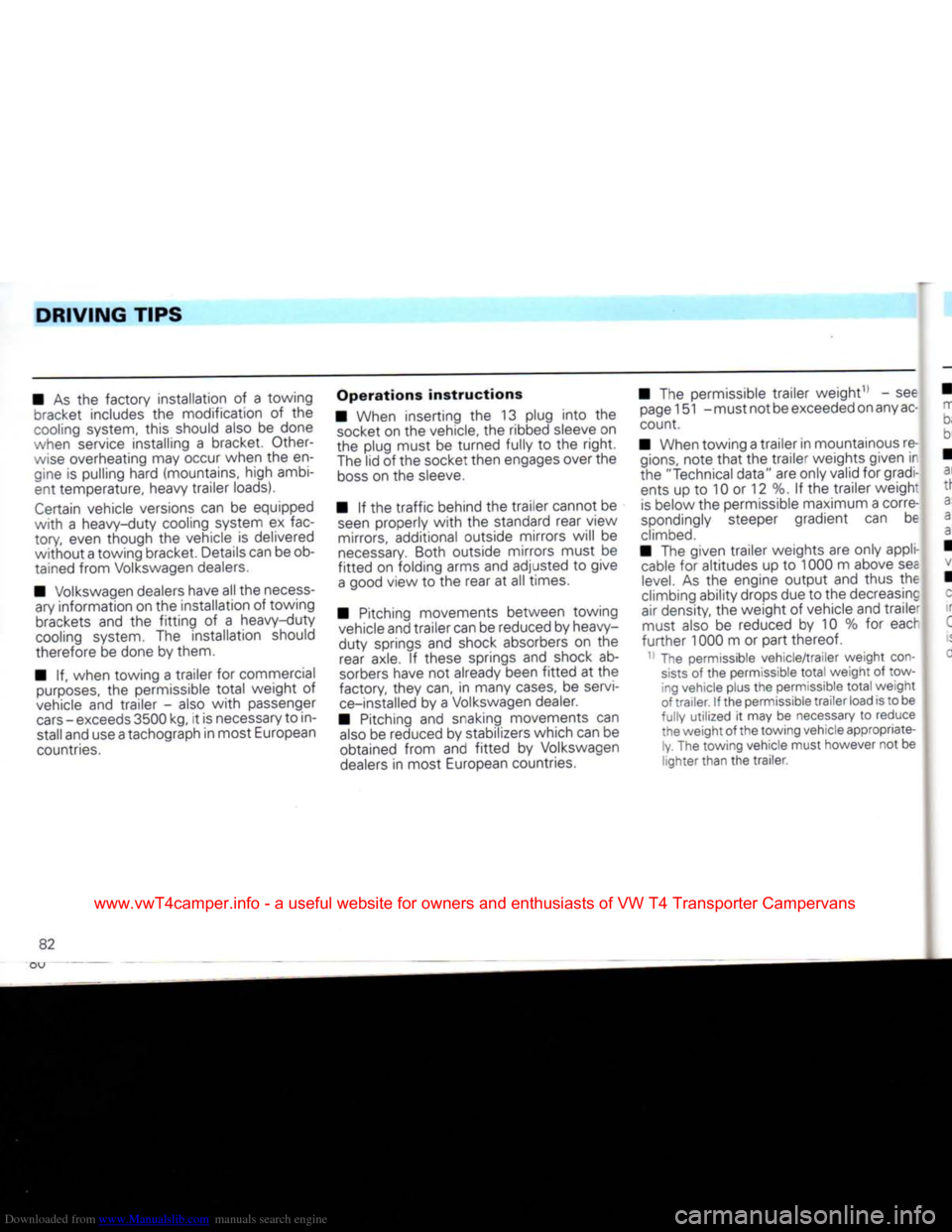
Downloaded from www.Manualslib.com manuals search engine
DRIVING
TIPS
• As the factory installation of a towing bracket includes the modification of the
cooling
system, this should also be done
when service installing a bracket. Other
wise
overheating may occur when the en gine is pulling hard (mountains, high ambi
ent temperature, heavy trailer loads).
Certain
vehicle versions can be equipped
with
a heavy-duty cooling system ex fac
tory,
even though the vehicle is delivered
without
a towing bracket. Details can be ob
tained from Volkswagen dealers.
• Volkswagen dealers have all the
necess
ary information on the installation of towing
brackets
and the
fitting
of a heavy-duty
cooling
system. The installation should
therefore be done by them.
• If, when towing a trailer for commercial
purposes,
the permissible
total
weight of
vehicle
and trailer - also
with
passenger
cars
- exceeds 3500 kg, it is necessary to in
stall and use a tachograph in most European
countries.
Operations
instructions
• When inserting the 13 plug
into
the
socket
on the vehicle, the ribbed sleeve on
the plug must be turned fully to the
right.
The
lid of the socket then engages over the
boss
on the
sleeve.
• If the
traffic
behind the trailer cannot be
seen
properly
with
the standard rear view mirrors, additional outside mirrors will be
necessary.
Both outside mirrors must be
fitted
on folding arms and adjusted to give
a
good view to the rear at all times.
• Pitching movements between towing
vehicle
and trailer can be reduced by heavy-
duty springs and shock absorbers on the rear axle. If these springs and shock ab
sorbers
have not already been
fitted
at the
factory, they can, in many
cases,
be servi
ce-installed
by a Volkswagen dealer.
• Pitching and snaking movements can
also
be reduced by stabilizers which can be
obtained from and
fitted
by Volkswagen
dealers
in most European countries. • The permissible trailer weight11 - see
page
151 -must not be
exceeded
on any
ac
count.
• When towing a trailer in mountainous re
gions,
note
that
the trailer weights given ir
the "Technical data" are only valid for gradi ents up to 10 or 12 %. If the trailer weigh'
is
below the permissible maximum a corre
spondingly steeper gradient can be
climbed.
• The given trailer weights are only appli
cable
for altitudes up to 1000 m above see
level.
As the engine
output
and thus the
climbing ability drops due to the decreasing
air density, the weight of vehicle and trailer must also be reduced by 10 % for eacr
further
1000 m or part thereof.
1 The permissible vehicle/trailer weight
con
sists
of the permissible
total
weight of towing vehicle plus the permissible
total
weight
of trailer. If the permissible trailer load is to be
fully utilized it may be necessary to reduce
the weight of the towing vehicle appropriate ly. The towing vehicle must however not be
lighter than the trailer.
82
www.vwT4camper.info - a useful website for owners and enthusiasts of VW T4 Transporter Campervans